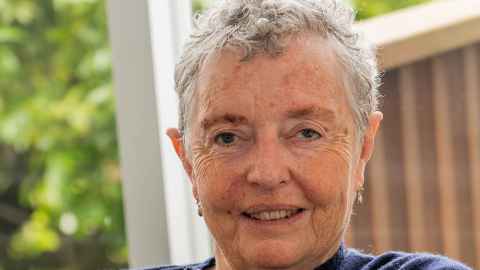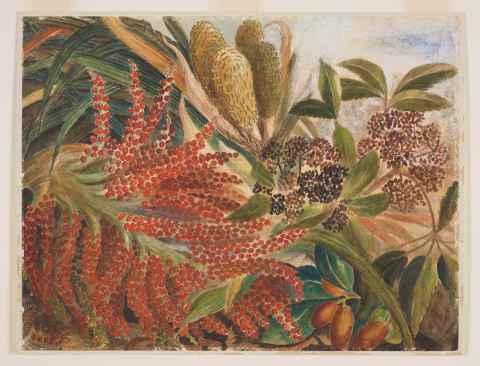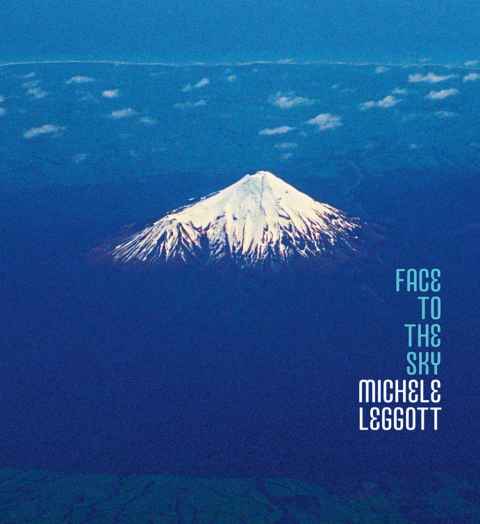Q and A with poet Michele Leggott
17 May 2023
Emeritus Professor Michele Leggott answers questions about her new poetry collection 'Face to the Sky' and her miraculous cancer treatment.

You’ve been researching New Zealand artist and writer Emily Cumming Harris for a long time. What drew you to her?
We share a Taranaki background. Emily Harris landed with her immigrant family on the beach at Ngāmotu in 1841 when she was four years old. My brother, sister and I played on the same black sand 120 years later. Emily’s first poems were written in New Plymouth and the idea that I had a poetic predecessor, shadowy but actual, was too good to pass up. I began a hunt for the poems that has taken me also to Emily’s beautiful and botanically accurate paintings and drawings.
How does a blind person research the work of an artist?
Sadly, I did not encounter Emily Harris’s paintings when I could see. But I know about archives and Emily is a consummate archivist of her work and her family history. I thought I could tell a good story about the Harrises, who were artists and teachers, almost all of them women, in the difficult spaces of colonial history. I was sure I could put Emily’s paintings into play by working with researchers who can see. Over the years, I have learned that asking questions about visuals can elicit responses that are useful to all parties. You go deeper into a work when one question leads to another. It’s like doing radio for pictures. Art historian Mary Kisler is a hero of mine.
Where does poetry fit into this kind of enquiry?
My Emily work was bounding along, though we still didn’t have more than a handful of poems from the 1860s and 1890s. We know Emily had a body of poems because she was quoting from them around the turn of the 20th century, but that file or folder has disappeared. I didn’t have Emily’s poems, but I had an increasing number of my own responses to her life and career. They helped me think about the archival and critical project. Eventually, I came to see that they were part of Face to the Sky, the poetry collection that was shaping itself alongside the archival enquiry.

Sadly, I did not encounter Emily Harris’s paintings when I could see.
So, research and poetry and then … cancer. What can you tell us about that?
I was diagnosed with non-Hodgkin’s diffuse large B-cell lymphoma just as Covid arrived in 2020 and the whole world turned upside down. Chemotherapy and radiation failed to eliminate the cancer. A stem-cell transplant in 2021 was also unsuccessful. I was referred for enrolment in the Malaghan Institute’s CAR-T immunotherapy trial in Wellington, but for a long time, my blood counts weren’t good enough to go on the trial. Then, in September 2022, they improved just enough and I was accepted. The team at Wellington Hospital collected T-cells from me and we went home to wait while the Malaghan scientists converted them into CAR T-cells. Malaghan’s chimeric antigen receptor T-cells are modified to hunt down and destroy cancer cells. We went back to Wellington for the infusion of the transformed cells in November and three months later, this February, I was given an all-clear: complete metabolic remission. Simply put, CAR T-cell therapy saved my life.
How do you fill your days now?
I have two books to take care of. Face to the Sky is my eleventh poetry collection. The Emily poems are part of the book, which has a strong Taranaki locus and just a flavour of the cancer years. It was completed before I knew the outcome of the CAR-T and represents (for me, anyway) a knife edge that could have gone either way. The second book is my Emily Harris investigation, still in draft and with the entrancing prospect of becoming richer in scope and detail as we continue to make discoveries.
Such as?
We are chasing a promising lead that links Emily’s paintings of weird and wonderful plants from the sub-Antarctic islands with specimens now at Te Papa, collected by botanist Thomas Kirk on his trip to the islands in 1890. Imagine: we can look at Kirk’s dried specimens and match them with some of Emily’s watercolours and oils. Art and science hand in hand.
Like poetry and CAR-T?
Yes. One has given me a new life, the other supplied respite from seemingly endless rounds of treatment. It took a long time to find my writing through the haze of fatigue and anxiety. But once I had it, the research and the poetry (and the poetry that is research), I could again put something into play, alongside the miraculous cells that were doing the heavy lifting. Body and mind, mind and body. A miracle.

Face to the Sky, a poetry collection by Michele Leggott, Auckland University Press, $35
This story first ran in the Autumn 2023 Ingenio magazine.